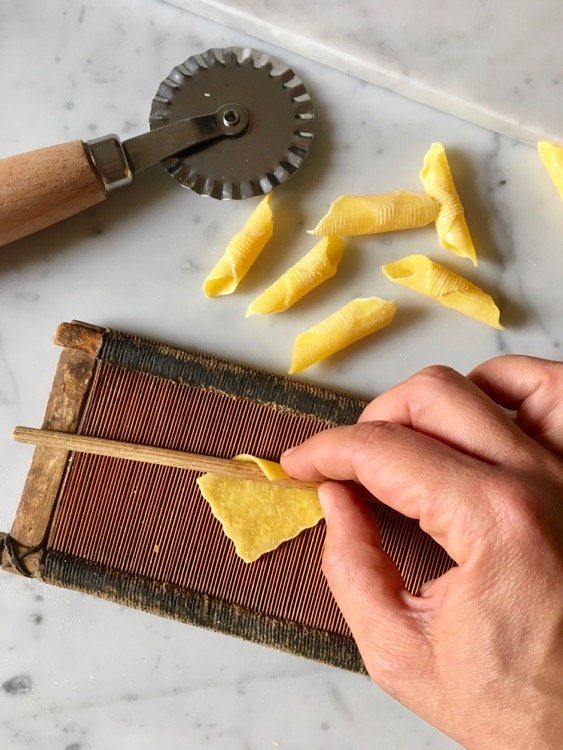Say egg pasta, and you think of Emilia.
But not this time. Garganelli is a traditional egg pasta from Romagna.
Even if the origin is lost between myth and legend, the sources are almost unanimous in believing that the birth of this pasta’s shape took place in the area of Imola, the place where I was born and raised.
It is a macaroni made on a special comb by rolling a square of pasta dough on a stick and pressing it on. I still have all the old combs and sticks that belonged to my grandmother. The same we used to make macaroni alla romagnola together.
If you look closely, you will see combs and sticks worn but alive, silent witnesses of hours and happy chats. I keep recipes and tools with equal love. The recipes are a map of memories, and the tools are archaeological pieces of my life.
Do you preserve the old kitchen tools of your family?

The origins: nobles’ or peasants’ pasta?
We will probably never know whether garganelli are to be attributed to the cuisine of Caterina Sforza, lady of Imola and Forlì, married to Girolamo Riario from Imola, or to that of Cardinal Bentivoglio, papal legate in Romagna. In both cases, legend has it that the filling was eaten (or thrown away by mistake), and the pasta dough usually used to make cappelletti became macaroni.
According to these sources, it is probable that garganelli originated in some country farmhouse in the lowlands of Romagna, in the area between Imola and Lugo, using old weaving combs that in the houses of the past, where simple woolen clothes were self-produced, were certainly not lacking.
Whatever its origins, all sources point to a pastry without filling. For sure, it was a far-sighted hand that invented maccherone al pettine (comb macaroni).
Once cooked in broth, today garganelli is eaten dry as a first course.
Just a last tip before the recipe. If in Romagna you don’t season garganelli with a generous amount of sauce, they will immediately understand that you are a foreigner.

You can season garganelli with many different sauces: fish, meat or vegetables.
My favorite sauces are sausage ragù, Bolognese ragù, shallots from Romagna plus sweet bacon, clams, crispy vegetables, or prosciutto and peas.
And then there is the classic recipe a la Jader. It means that you open the fridge and cook (to discover the reasons for this statement, I’ll wait for you in the post with the recipe for garganelli with a tasty sauce).
I have recently added a new sauce to this list called Via Emilia. It is a recipe I cooked at a national cooking competition. And I won.
Garganelli is a traditional egg pasta: eggs and flour, cutting board, and rolling pin.
Since it is a striped macaroni, you can’t do without a comb, which you can buy online.
Lace-up your apron and set up a clean work surface where you can prepare and roll out the pasta with a rolling pin or a pasta machine, whichever you prefer. And if you want to know the secrets, tricks, and curiosities of making egg pasta, there is a post on the blog dedicated to this preparation.
Buona cucina
Monica
Keep in Touch.
If you like, you can follow me on Instagram, Pinterest and Facebook.

Food tips.
Add a handful of semolina to make the pasta dough, and therefore the pasta, rougher: it will pick up the sauce better.
Learn to make garganelli from Imola
serves 4
List of Ingredients
flour 0, 400 g
eggs, 4
tip: add a handful of semolina to the flour
Method
For the different steps to make pasta dough, read the post on preparing it.
Put the flour on the cutting board and create a space in the center where adding the eggs.
Knead until the dough is smooth and compact. Let the dough rest wrapped in plastic wrap or a plastic bag for about 20 minutes.
To make the garganelli, roll out the dough with a rolling pin or pasta machine to a thin sheet about 2mm thick.
Cut pasta dough squares of about 3-4 cm per side. Cover the unused pastry with cling film or a clean towel to prevent it from drying out.
Place a square on the comb, place the stick over a tip of one of the four corners, start to roll it up, and then pass the macaroni back and forth on the comb to seal it and imprint the lines of the comb on the pastry.
Then pull the macaroni off the stick and, little by little, place them, slightly apart, on a lightly floured tray. Leave to dry for a couple of hours or cook immediately.


